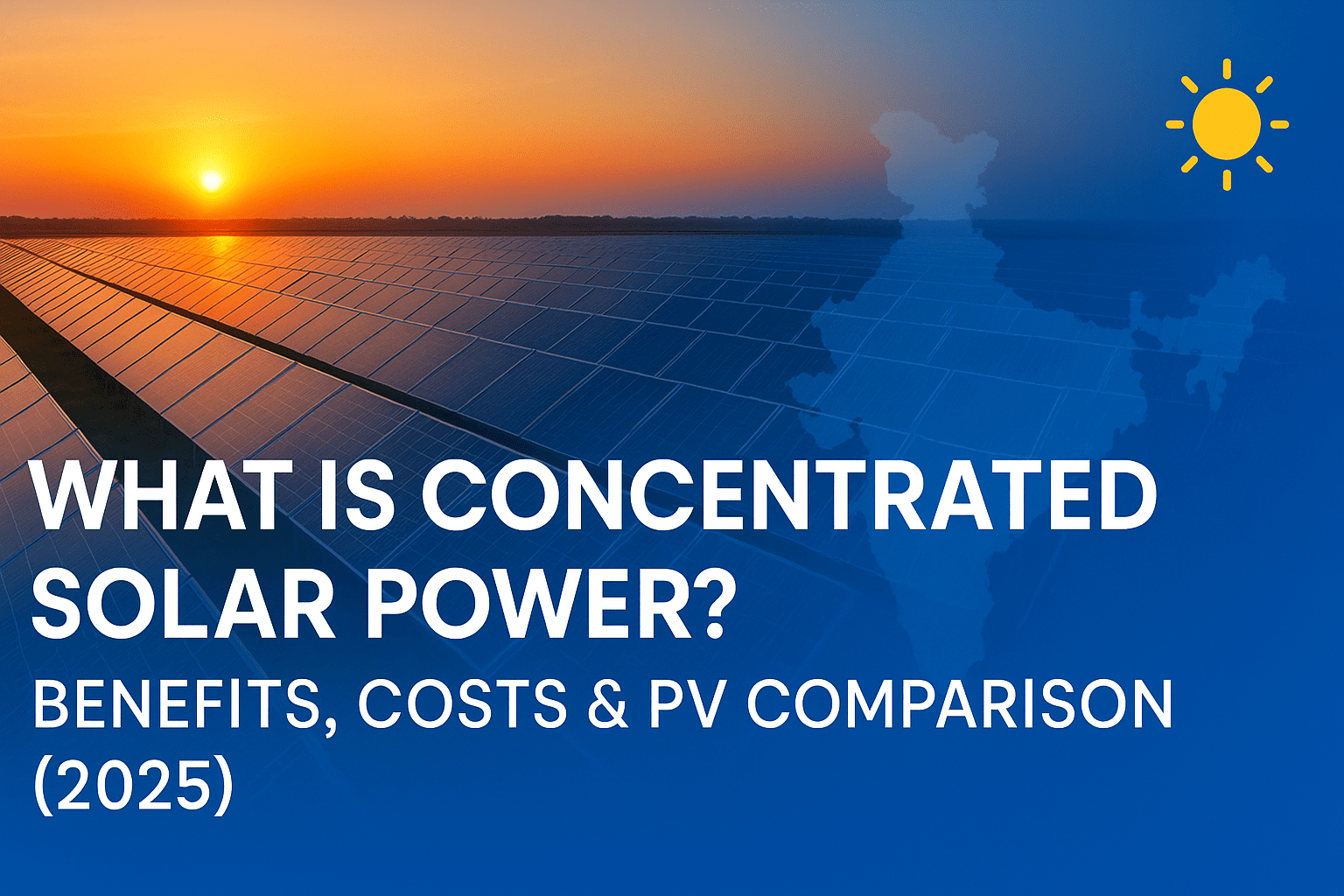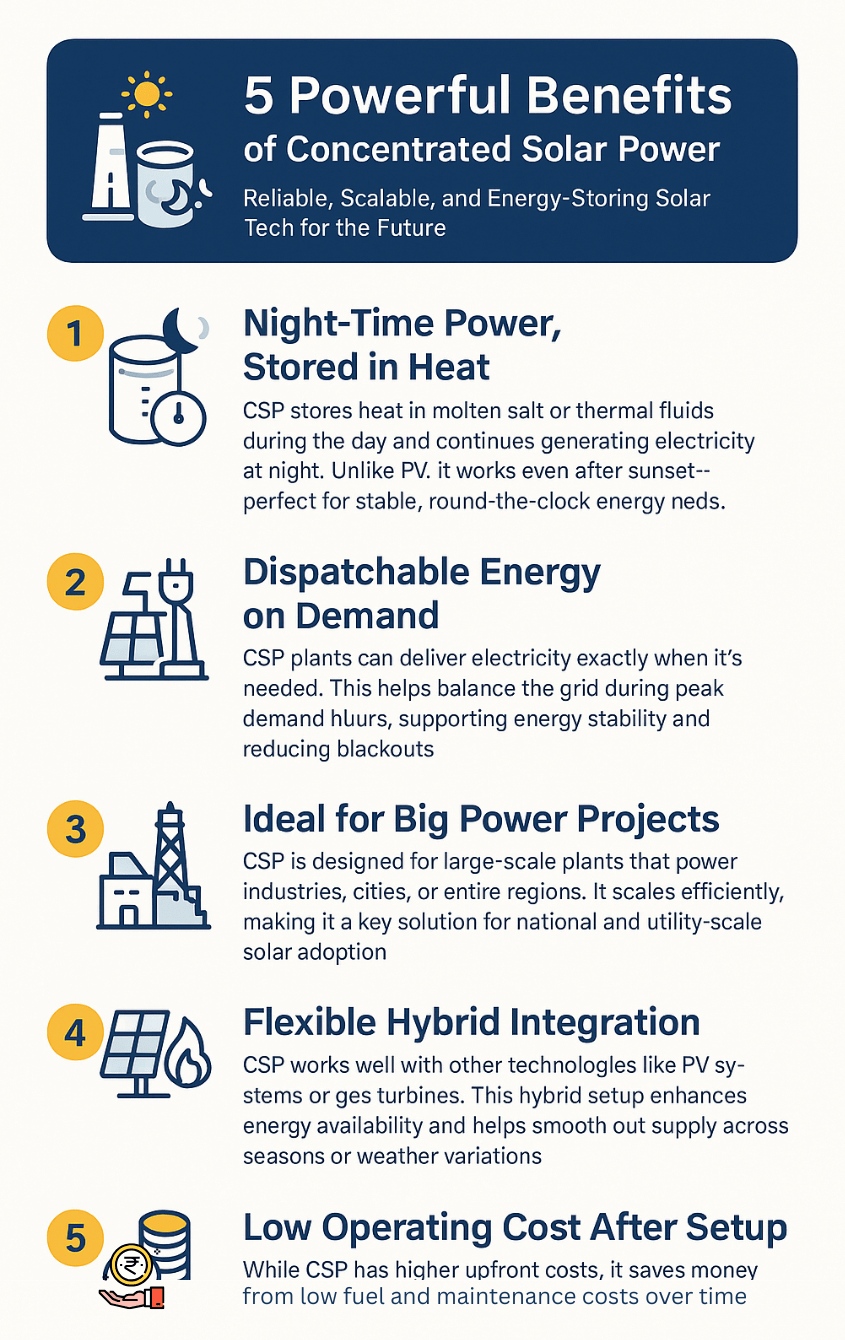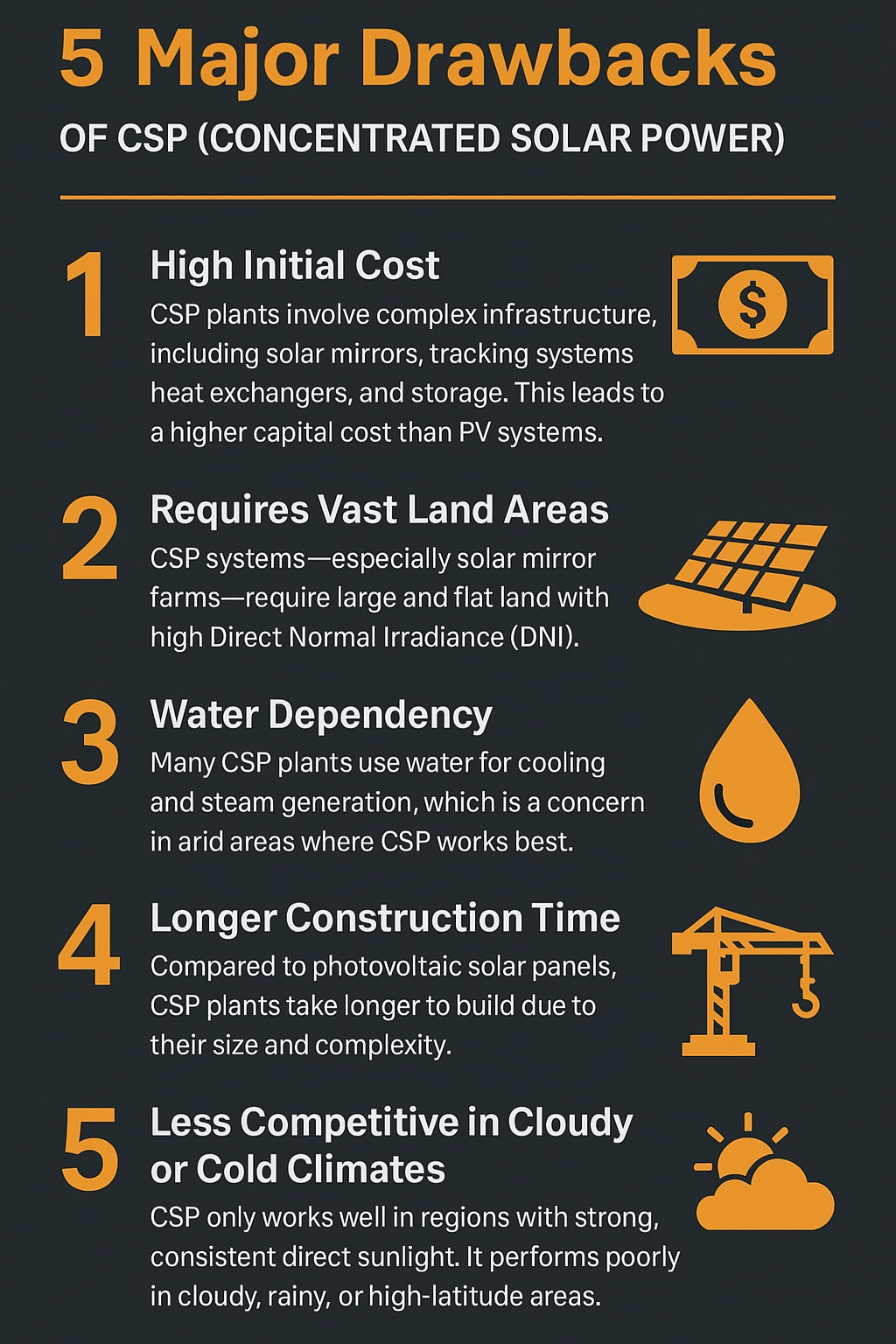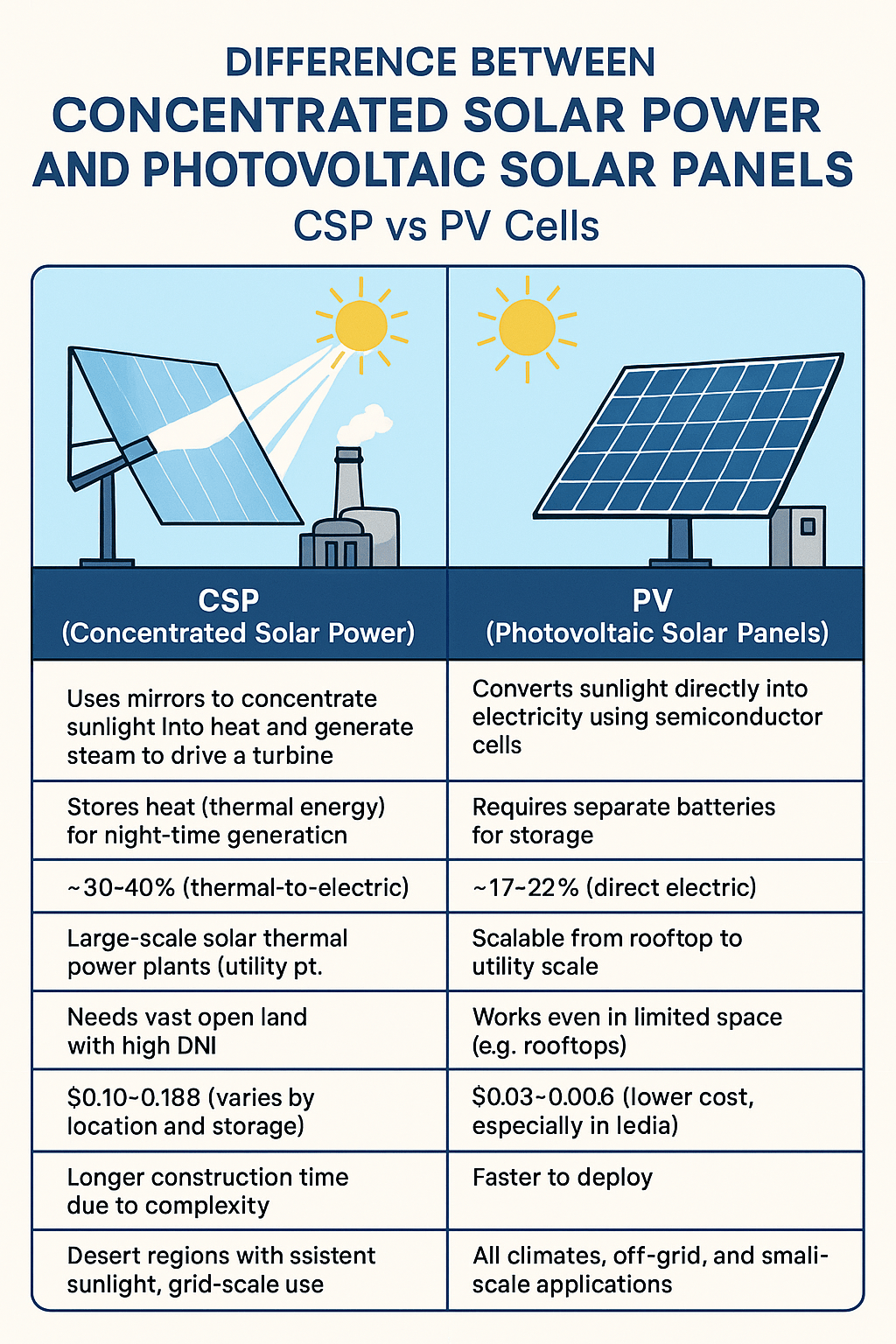India’s Bright Future with Solar Heat Technology
Feeling the heat? What if we could turn that sunlight into powerful electricity, day and night? That’s exactly what concentrated solar power (CSP) does.
Unlike regular solar panels, CSP uses mirrors to focus sunlight into a small area. This heat is used to make steam, which spins turbines and creates electricity, even after sunset. Sounds smart, right?
India, with its blazing sun and energy needs, is the perfect place for CSP solar. From industries to power grids.
In this guide, you’ll learn:
- What is CSP and How it works in simple terms
- History of CSP
- What are the components required
- What are the types
- Costs and efficiency
- Pros, cons and how it differ from PV system
- What about the CSP in India’s energy future
Let’s dive in and know how concentrated solar power is lighting the way for a greener, stronger India.
What is Concentrated Solar Power?
Concentrated Solar Power (CSP) is a renewable energy technology that captures sunlight and converts it into heat, which is then used to generate electricity. It uses mirrors or lenses to concentrate sunlight onto a receiver.
This concentrated heat is typically used to boil a fluid, produce steam, and spin a turbine just like conventional power plants, but without burning fossil fuels.
For this reason, CSP systems are often referred to as solar thermal power plants.
Whether you’re a student, enthusiast, or commercial decision-maker, this guide will give you a complete overview of The history, Key components, Different CSP technologies, Efficiency, Cost breakdowns, Pros and cons, CSP vs PV comparison and Global and Indian installations.
Brief History of Concentrated Solar Power (CSP)
The concept of using mirrors to harness the sun’s heat isn’t new. Concentrated Solar Power (CSP) has evolved through centuries of innovation, experimentation, and modern engineering.
Curious about how solar energy started? Read the full history of solar power here.
Early Beginnings
The idea of using mirrors to harness sunlight goes back to ancient times. Archimedes is believed to have used bronze mirrors to focus sunlight on enemy ships.
In the 1800s, French inventor Augustin Mouchot built one of the first solar steam engines using curved mirrors.
Early 20th Century
In 1913, Frank Shuman built the first working solar thermal power plant in California. It used parabolic troughs to boil water and run a steam engine.
Growth in the Late 1900s
During the 1970s oil crisis, CSP gained attention. The U.S. and Europe funded projects to reduce reliance on fossil fuels.
The SEGS plants in California (1980s–1990s) became the first large-scale CSP systems—and are still among the biggest today.
CSP Today
Since the 2000s, CSP technology has improved with solar mirror farms, heat storage, and tower systems.
Countries like Spain, the U.S., and India now invest in CSP for utility-scale use. In India, Rajasthan and Gujarat are top regions due to strong sunlight and open land. Source: Aalborg CSP – History of Parabolic Troughs
What Are the Main Components of a CSP Plant
A Concentrated Solar Power plant works like a traditional thermal power station but uses the sun’s heat instead of fossil fuels. There are three main parts that make the system work efficiently.
1. Solar Collectors (Mirrors or Lenses)
These are large curved mirrors, often arranged in long rows or circular layouts that capture and focus sunlight onto a central point or pipe. This concentrated light creates very high temperatures.
Commonly used parabolic troughs and heliostats in solar mirror farms.
2. Receiver System
The receiver is placed where the sunlight is focused. It absorbs the heat and transfers it to a heat-transfer fluid like molten salt or synthetic oil. This fluid is heated to extreme temperatures and used to produce steam.
3. Power Block (Turbine & Generator)
The hot fluid moves through a heat exchanger to generate steam. This steam spins a turbine connected to a generator, which then produces electricity just like in any thermal power plant.
What Are the Different Types of CSP Systems?
There are four main types of CSP systems. Each one uses a different way to collect and focus sunlight, but all aim to produce heat and convert it into electricity. Here’s how they work.
1. Parabolic Trough Systems
These are the most common types of CSP solar plants. Long, curved mirrors (troughs) focus sunlight onto a tube running through the centre. A heat-transfer fluid flows through the tube, collecting the heat to produce steam.
- Widely used in India and the U.S.
- Suitable for utility-scale solar thermal power plants
2. Power Tower Systems (Central Receiver)
These use hundreds of flat mirrors (heliostats) that track the sun and reflect sunlight onto a central receiver at the top of a tall tower. The intense heat melts salt or heats oil, which is stored and used to create steam.
- Offers higher temperatures and efficiency
- Works well with thermal energy storage systems
3. Linear Fresnel Reflector Systems
This design uses flat, narrow mirrors to focus sunlight onto a fixed receiver above. It’s similar to the parabolic trough but cheaper and more compact.
- Lower cost, simple design
- Good for industrial steam generation
4. Dish Stirling Systems
These systems use a dish-shaped mirror to focus sunlight onto a receiver placed at the focal point. The heat drives a Stirling engine to generate electricity.
- High efficiency on a small scale
- Often used in remote or off-grid areas
Requirements for Concentrated Solar Systems Plant
Setting up a Concentrated Solar Power plant involves more than just installing mirrors in the sun. These systems need specific environmental, technical, and financial conditions to operate efficiently, especially at utility scale.
Here are the key requirements for building a successful solar thermal power plant:
1. High Solar Radiation (DNI)
CSP systems need Direct Normal Irradiance (DNI), sunlight that travels in a straight line without scattering.
This is why CSP works best in desert and semi-arid regions like Rajasthan and Gujarat in India, Sahara Desert, Southwestern United States, Northern Chile’s Atacama Desert, Australia’s Outback, and parts of the Middle East are prime zones for CSP due to their high DNI values.
2. Large Land Area
CSP plants, especially solar mirror farms, require a lot of flat, open land to install mirrors or heliostats with sufficient spacing to avoid shading.
Utility-scale concentrated solar power plants need hundreds of acres for optimal layout.
3. Access to Water Resources
Water is used for cooling and steam generation in many CSP designs. Although dry-cooling technologies are improving, access to water still improves plant efficiency and cost-effectiveness.
4. Connection to High-Capacity Grid Infrastructure
CSP plants generate large amounts of electricity. They must be connected to a reliable, high-voltage transmission network to deliver power to demand centers.
5. Upfront Capital & Financing
CSP has higher upfront costs compared to PV, making government incentives, international funding, and private sector investments essential for scaling.
How Efficient Are Mirror-based Solar Thermal Power Plants?
The efficiency of a CSP plant refers to how much sunlight it can convert into usable electricity. While efficiency depends on system type, location, and design, CSP generally performs well in sun-rich regions.
Average CSP Efficiency
- CSP systems typically have a thermal-to-electric efficiency of 30–40%.
- Systems using molten salt storage and tower technology can reach the higher end of this range.
- Advanced designs may go beyond 40% under ideal conditions.
Efficiency Of CSP vs Photovoltaics (PV)
There are average efficiency comparisons between various green energies:
| Technology | Typical Efficiency | Notes |
| CSP (Solar Thermal) | 30–40% | Better for large-scale, stored energy |
| PV Solar Panels | 17–22% | More efficient in cloudy weather, easier to install |
| Wind Turbines | 35–45% | Varies with wind speed |
| Hydropower | 85–90% | Most efficient, but location limited |
Source: U.S. DOE and NREL CSP Technology Reports
Cost of Concentrated Solar Power (CSP)
The cost of generating electricity from Concentrated Solar Power (CSP) is measured using Levelized Cost of Energy (LCOE), a metric that averages the total cost of building and operating a power plant over its lifetime.
Current LCOE of CSP
- As of 2023, the global average LCOE for CSP ranges between $0.10 and $0.18 per kWh, depending on the project size, technology, and location.
- According to the International Renewable Energy Agency (IRENA), the cost has dropped significantly from $0.30+ per kWh in 2010 thanks to improved designs and thermal storage systems.
- Projects in the Middle East and North Africa (MENA Reports) have achieved LCOEs as low as $0.07 per kWh under optimal solar conditions.
CSP vs Other Renewable Energy Costs
|
Technology |
Avg. LCOE (2023) | Trend |
| CSP | $0.10 – $0.18 | Falling steadily, still more than PV |
| PV Solar Panels | $0.03 – $0.06 | Lowest cost, especially in India & China |
| Wind (Onshore) | $0.03 – $0.07 | Competitive and growing globally |
| Hydropower | $0.02 – $0.05 |
Low cost but limited by geography |
Why CSP Costs More
CSP requires complex infrastructure, high upfront investment, and big land areas, which increase initial costs. However, CSP offers thermal storage and dispatchable power, giving it an edge in round-the-clock clean energy delivery.
India Outlook
CSP adoption in India has been slow due to higher costs than solar PV. But with growing energy demand and better solar mirror technologies, CSP could play a role in hybrid and grid-scale storage systems in the near future.
What Are the Pros and Cons of CSP
Like any renewable energy technology, Concentrated Solar Power (CSP) comes with both strengths and limitations.
CSP is most effective in sunny regions like India, Spain, the Middle East, and parts of the U.S., where its benefits such as storage and reliability.
Here’s a detailed strengths and limitations of CSP:
What are the advantages of CSP (Concentrated Solar Power)?
Concentrated Solar Power offers several key advantages, especially for large-scale power generation in sunny regions. Below are the main benefits of CSP explained simply:
1. Thermal Energy Storage for Night-Time Power
Unlike PV systems that stop producing electricity after sunset, CSP can store heat in molten salts or fluids and generate power even at night. It makes stable grid supply.
2. Grid-Ready, Dispatchable Power
CSP plants can control when electricity is delivered to the grid. This ability to dispatch power on demand helps stabilise power supply during peak hours.
3. Scalable for Utility-Scale Projects
CSP is best suited for large solar thermal power plants, making it effective for meeting industrial or city-level power needs.
4. Supports Hybrid Energy Systems
CSP can be combined with other technologies like photovoltaics or even fossil fuels for hybrid generation systems. This improves flexibility and energy reliability.
5. Low Operating Costs After Installation
Though CSP has high setup costs, it benefits from low fuel and maintenance costs over time since the main energy input (sunlight) is free and abundant.
What are the disadvantages of CSP (Concentrated Solar Power)?
While Concentrated Solar Power (CSP) offers valuable benefits, it also comes with several challenges that limit its adoption, especially when compared to solar PV and wind. Here are the main disadvantages explained clearly:
1. High Initial Cost
CSP plants involve complex infrastructure, including solar mirrors, tracking systems, heat exchangers, and storage. This leads to a higher capital cost than PV systems.
2. Requires Vast Land Areas
CSP systems- especially solar mirror farms require large and flat land with high Direct Normal Irradiance (DNI). This can be a barrier in densely populated or uneven terrains. Only selective regions like Rajasthan and Gujarat meet these conditions.
3. Water Dependency
Many CSP plants use water for cooling and steam generation, which is a concern in arid areas where CSP works best. Dry cooling options exist, but they reduce system efficiency and raise costs.
4. Longer Construction Time
Compared to photovoltaic solar panels, CSP plants take longer to build due to their size and complexity.
5. Less Competitive in Cloudy or Cold Climates
CSP only works well in regions with strong, consistent direct sunlight. It performs poorly in cloudy, rainy, or high-latitude areas, limiting its global usability.
Want a clear breakdown on solar energy? See the pros and cons of solar energy.
Difference Between Concentrated Solar Power and Photovoltaic Solar Panels(CSP vs PV Cells)
Both Concentrated Solar Power (CSP) and Photovoltaic (PV) systems convert sunlight into electricity but they do it in very different ways. Here’s how they compare across key factors:
Key Differences between CSP and PV
| Feature | CSP (Concentrated Solar Power) | PV (Photovoltaic Solar Panels) |
| Working Principle | Uses mirrors to concentrate sunlight into heat and generate steam to drive a turbine | Converts sunlight directly into electricity using semiconductor cells |
| Energy Storage | Stores heat (thermal energy) for night-time generation | Requires separate batteries for storage |
| Efficiency Range | ~30–40% (thermal-to-electric) | ~17–22% (direct electric) |
| Installation Size | Large-scale solar thermal power plants (utility projects) | Scalable from rooftop to utility scale |
| Land Requirement | Needs vast open land with high DNI | Works even in limited space (e.g., rooftops) |
| Cost per kWh (LCOE) | $0.10–$0.18 (varies by location and storage) | $0.03–$0.06 (lower cost, especially in India) |
| Deployment Speed | Longer construction time due to complexity | Faster to deploy |
| Best Suited For | Desert regions with consistent sunlight, grid-scale use | All climates, off-grid and small-scale applications |
Which Is Better?
- Use CSP when you need dispatchable power with storage for grid-scale energy in sun-rich regions.
- Use PV when you need a quick, low-cost solution for homes, businesses, or hybrid systems.
What Are Some of the Main Applications of CSP?
Concentrated Solar Power (CSP) isn’t just for electricity, it also supports industrial processes that require steady, high-temperature heat. Here are the key use cases:
- Grid-Scale Electricity – CSP powers utility-scale solar thermal plants with thermal storage for day and night energy.
- Solar Desalination – CSP heat is used to convert seawater into freshwater in arid regions.
- Industrial Process Heat – CSP supplies clean, high-temperature heat for industries like cement, food, and chemicals.
- Hybrid Systems & R&D – CSP is combined with PV, gas, or batteries, and supports research in hydrogen and thermal innovation.
Which Country Has the Most CSP Installations?
As of 2024, Spain leads the world in CSP capacity. Spain has over 2.3 GW of installed CSP capacity across 50+ plants, making it the global leader in CSP deployment.
Other top CSP countries include:
- USA – ~1.7 GW
- Morocco – ~0.5 GW
- UAE, China, and South Africa are rapidly scaling CSP projects.
Source: IEA Technology Report on CSP
How Many CSP Plants Are There in India?
As of 2024, India has around 7 operational Concentrated Solar Power (CSP) plants, with a total capacity of nearly 250 megawatts (MW). Most of these are pilot or demonstration projects supported under the National Solar Mission.
Major CSP Plants in India:
- Godawari Solar Project (Rajasthan) – 50 MW
- Megha Solar Plant (Andhra Pradesh) – 50 MW
- ACME Solar Tower (Rajasthan) – 2.5 MW (demonstration project)
- Dhirubhai Ambani Solar Park Project (Rajasthan) – 125 MW (cancelled later, but part of earlier plans)
These plants are mainly located in sun-rich states like Rajasthan and Andhra Pradesh. Although CSP growth in India is slower compared to photovoltaic (PV) systems. CSP still holds promise for hybrid power solutions and thermal storage in dry regions. Source: NREL national laboratory of the U.S. Department of Energy
Conclusion: Is Concentrated Solar Power the Future of Utility-Scale Clean Energy?
Concentrated Solar Power (CSP) offers a powerful alternative to traditional solar technologies by delivering on-demand electricity using stored thermal energy. While it requires more space and investment than PV, it shines in sun-rich regions with high energy demands.
CSP is best suited for utility-scale applications, hybrid systems, and industries needing reliable, round-the-clock power. With advancements in thermal storage and mirror technology, CSP can play a key role in future-ready clean energy grids and especially in countries like India, Spain, and the U.S.
👉 Curious how CSP fits into the broader world of solar energy? Read our complete guide to solar energy and its future to discover all technologies powering the solar revolution.
FAQs: Concentrated Solar Power (CSP)
Q1: What is the main difference between CSP and PV?
CSP (Concentrated Solar Power) uses mirrors or lenses to concentrate sunlight into heat, which drives a steam turbine to generate electricity. In contrast, PV systems convert sunlight directly into electricity using semiconductor cells.
Q2: Is CSP better than PV for large-scale solar projects?
Yes, CSP is typically more suitable for utility-scale applications where energy storage and on-demand power delivery are important. Its ability to store thermal energy allows it to provide electricity even when the sun isn’t shining.
Q3: Does CSP work at night?
Yes. CSP plants are equipped with thermal storage to store heat during the day and use it to generate electricity after sunset.
Q4: Is CSP used in India?
Yes, CSP technology is used in India, though to a lesser extent than PV. Rajasthan and Gujarat are the key regions for CSP projects due to their high Direct Normal Irradiance (DNI) and availability of open land.





